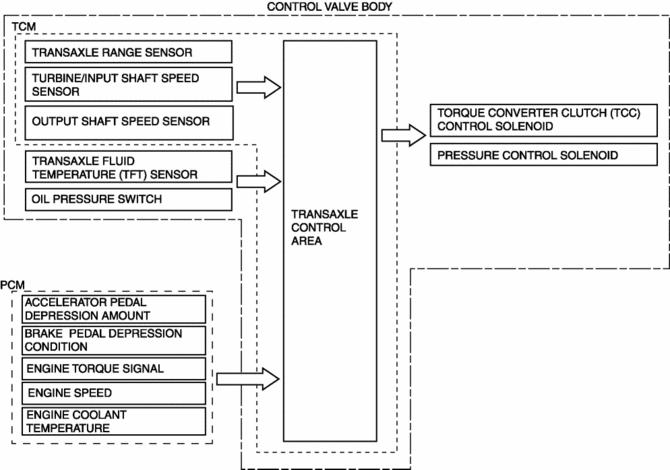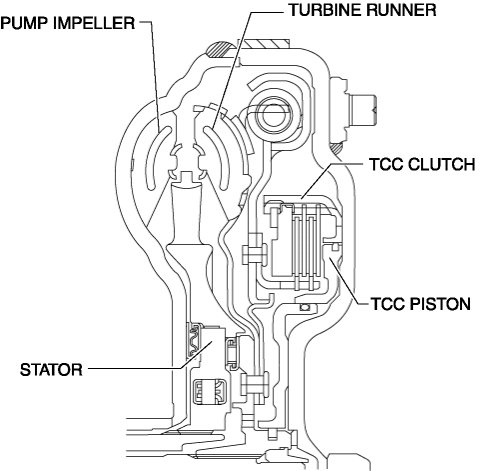Mazda CX-5 Service & Repair Manual: Torque Converter Clutch (TCC) Control [Fw6 A EL, Fw6 Ax EL]
Outline
-
For TCC control, a newly developed, full range TCC control has been adopted. The TCC range has been significantly widened by having the smoothness unique to the torque converter during acceleration from a stop take precedence and actively controlling TCC directly after acceleration from a stop. Therefore, a contribution to low fuel consumption and vehicle operability with a direct feel have been achieved.
-
Lower fuel consumption and improved emission performance have been achieved by performing the TCC control during deceleration with the accelerator pedal fully closed and by fuel-cut during TCC.
Construction

-
The TCC mechanism consists of a torque converter clutch, TCC piston, and a damper which are installed inside the torque converter.
-
A multi-plate type torque converter clutch has been adopted for improved durability. Also, by reducing the size of the clutch diameter, improved handling is achieved by the ability to respond to the precise control by the full range TCC.
-
Vibration during TCC engagement is suppressed by the improved damper performance.

Operation
-
TCC engagement
-
A current signal is sent from the TCM to the TCC control solenoid during TCC engagement. At the same time, the TCC piston engagement pressure is gradually increased.
-
As a result, the TCC piston is pressure-bonded to the TCC clutch slowly to perform smooth TCC engagement.
-
TCC release
-
A current signal is sent from the TCM to the TCC control solenoid during TCC release. At the same time, the TCC piston engagement pressure is gradually drained.
-
As a result, the TCC piston releases the TCC clutch slowly to release the TCC smoothly.
-
Inhibition of TCC control
-
If any one of the following conditions is met, the torque converter clutch control is inhibited.
-
TCC solenoid malfunction
-
ATF temperature is specification or less
-
Engine speed signal is specification or less
-
Turbine shaft speed is specification or less
-
Other than D/M position
 Torque Converter Clutch (TCC) Control Solenoid [Fw6 A EL, Fw6 Ax EL]
Torque Converter Clutch (TCC) Control Solenoid [Fw6 A EL, Fw6 Ax EL]
Purpose/Function
The torque converter clutch (TCC) control solenoid adjusts the hydraulic
pressure in the TCC control circuit based on the current demand from the TCM
according to the veh ...
 Torque Converter [Fw6 A EL, Fw6 Ax EL]
Torque Converter [Fw6 A EL, Fw6 Ax EL]
Purpose/Function
By use of an optimized torus shape (wing) matching the output characteristics
of the engine, the torque converter achieves efficient force transmission and
reduced fuel c ...
Other materials:
Electric Variable Valve Timing Motor/Driver Removal/Installation
WARNING:
A hot engine can cause severe burns. Turn off the engine and wait until it
is cool before servicing.
CAUTION:
Applying excessive force (force of 100 N {10.2 kgf, 22.5 lbf} or more) to
the electric variable valve timing motor/driver may cause a malfunction. When
...
Add-On Non-Genuine Parts and Accessories
Non-genuine parts and accessories for Mazda vehicles can be found in stores.
These may fit your vehicle, but they are not approved by Mazda for use with Mazda
vehicles. When you install non-genuine parts or accessories, they could affect your
vehicle's performance or safety systems; the Maz ...
Accessory Socket
Purpose
By inserting the plug of an electrical device, 12 V (maximum 120 W) of power
is supplied enabling use of the electrical device in the vehicle.
Function
Front accessory socket
When the ignition is switched to ACC or ON (engine off or on), 12 V (maximum
120 W) of pow ...
